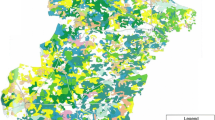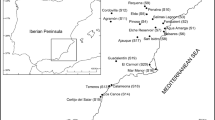Abstract
Investigating the relationships between vegetation dynamic and edaphic factors provide management insights into factors affecting the growth and establishment of plant species and vegetation communities in saline areas. The aim of this study was to assess the spatial variability of various vegetation communities in relation to edaphic factors in the Great Salt Desert, central Iran. Fifteen vegetation communities were identified using the physiognomy-floristic method. Coverage and density of vegetation communities were determined using the transect plot method. Forty soil samples were collected from major horizons of fifteen profiles in vegetation communities, and analyzed in terms of following soil physical and chemical characteristics: soil texture, soluble Na+ concentration, sodium adsorption ratio (SAR), electrical conductivity (EC), pH, organic matter content, soluble Mg2+ and Ca2+ concentrations, carbonate and gypsum contents, and spontaneously- and mechanically-dispersible clay contents. Redundancy analysis was used to investigate the relationships between vegetation dynamic and edaphic factors. The generalized linear method (GLM) was used to find the plant species response curves against edaphic factors. Results showed that plant species responded differently to edaphic factors, in which soluble sodium concentration, EC, SAR, gypsum content and soil texture were identified as the most discriminative edaphic factors. The studied plant species were also found to have different ecological requirements and tolerance to edaphic factors, in which Tamarix aphylla and Halocnemum strobilaceum were identified as the most salt-resistant species in the region. Furthermore, the presence of Artemisia sieberi was highly related to soil sand and gypsum contents. The results implied that exploring the plant species response curves against edaphic factors can assist managers to lay out more appropriate restoration plans in similar arid areas.
Similar content being viewed by others
References
Abbas M S, Afefe A A, Hatab E B E, et al. 2016. Vegetation-soil relationships in wadi El-Rayan protected area, western desert, Egypt. Jordan Journal of Biological Sciences, 9(2): 97–107.
Agarwal P, Dabi M, Kinhekar K, et al. 2020. Special adaptive features of plant species in response to salinity. In: Hasanuzzaman M, Tanveer M. Salt and Drought Stress Tolerance in Plants Signaling Networks and Adaptive Mechanisms. Switzerland: Springer, 53–76.
Allahgholi A, Asri Y. 2014. Changes in plant communities within the south east salt marshes of Orumieh Lake. Plant Ecophysiology, 5(15): 74–87. (in Persian)
Apaydin Z, Kutbay H G, Ozbucak T, et al. 2009. Relationships between vegetation zonation and edaphic factors in a salt-marsh community (Black Sea Coast). Polish Journal of Ecology, 57(1): 99–112.
Arevalo J R, Fernández-Lugo S, Reyes-Betancort J A, et al. 2017. Relationships between soil parameters and vegetation in abandoned terrace field vs. non-terraced fields in arid lands (Lanzarote, Spain): an opportunity for restoration. Acta Oecologica, 85: 77–84.
Asrari A, Bakhshikhaniki G H, Rahmatizadeh A. 2012. Assessment of relationship between vegetation and salt soil in Qom Province. Iranian Journal of Range and Desert Research, 19(2): 264–282. (in Persian)
Austin M P. 2005. Vegetation and environment: discontinuities and continuities. In: van der Maarel E. Vegetation Ecology. Oxford: Blackwell Publishing, 52–84.
Cao Q Q, Yang B M, Li J R, et al. 2020. Characteristics of soil water and salt associated with Tamarix ramosissima communities during normal and dry periods in a semi-arid saline environment. CATENA, 193: 104661.
Carter M R, Gregorich E G. 2008. Soil Sampling Methods of Analysis (2nd ed.). Boca Raton: CRC Press, 1224.
Cochran W G. 1977. The estimation of sample size. In: Cochran W G. Sampling Techniques (3rd ed.). New York: John Wiley & Sons, 72–86.
Czyż E A, Dexter A R. 2015. Mechanical dispersion of clay from soil into water readily-dispersed and spontaneously-dispersed clay. International Agrophysics, 29(1): 31–37.
de Martonne E. 1926. A new climatological function: the aridity index. La Météorologie, 2: 449–458. (in French)
Flowers T J, Troke P, Yeo A R. 1977. The mechanism of salt tolerance in halophytes. Annual Review of Plant Physiology, 28(1): 89–121.
Gonzalez-Alcaraz M N, Jimenez-Carceles F J, Alvarez Y, et al. 2014. Gradients of soil salinity and moisture, and plant distribution, in a Mediterranean semi-arid saline watershed: a model of soil-plant relationships for contributing to the management. CATENA, 115: 150–158.
Greig-Smith P. 1983. Quantitative Plant Ecology (3rd ed.). Oxford: Blackwell Scientific Publications, 374.
Hejcmanovā-Neźerková P, Hejcman M. 2006. A canonical correspondence analysis (CCA) of the vegetation-environment relationships in Sudanese savannah, Senegal. The South African Journal of Botany, 72(2): 256–262.
IMO. 2015. Iran Meteorological Organization Archive. [2015-09-20]. https://www.irimo.ir/eng/index.php.
Kent M. 2011. Vegetation Description and Data Analysis: A Practical Approach. New York: John Wiley & Sons, 414.
Khatibi R, Soltani S, Khodagholi M. 2017. Effects of climatic factors and soil salinity on the distribution of vegetation types containing Anabasis aphylla in Iran: a multivariate factor analysis. Arabian Journal of Geosciences, 10(2): 1–18.
Kleyer M, Dray S, Bello F, et al. 2012. Assessing species and community functional responses to environmental gradients: which multivariate methods? Journal of Vegetation Science, 23(5): 805–821.
Koull N, Chehma A. 2016. Soil characteristics and plant distribution in saline wetlands of Oued Righ, northeastern Algeria. Journal of Arid Land, 8(6): 948–959.
Magurran A E. 2004. Measuring Biological Diversity. Australia: Blackwell Science Ltd., 256.
Mokhtari-Asl A A F, Mesdaghi M, Akbarluo M, et al. 2008. Investigation on relationships between some soil characteristics and distribution of rangelands species (Case study: Eastern Azarbayjan-Marand Gherkhelar rangelands). Journal of Agricultural Sciences and Natural Resources, 15(1): 14–24. (in Persian)
Mueller-Dombois D, Ellenberg H. 1974. Aims and Methods of Vegetation Ecology. New York: Wiley & Son, 93–135.
Park H J, Hong M G, Kim J G. 2020. Effects of soil fertility and flooding regime on the growth of Ambrosia trifida. Landscape and Ecological Engineering, 16(1): 39–46.
Piernik A. 2012. Ecological Pattern of Inland Salt Marsh Vegetation in Central Europe. Poland: Nicolas Copernicus University Press, 229.
Quevedo D I, Frances F. 2008. A conceptual dynamic vegetation-soil model for arid and semiarid zones. Hydrology and Earth System Sciences, 12(5): 1175–1187.
Rengasamy P, Greene R, Ford G, et al. 1984. Identification of dispersive behaviour and the management of red-brown earths. Australian Journal of Soil Research, 22(4): 413–431.
Sahragard H P, Chahouki M Z. 2015. An evaluation of predictive habitat models performance of plant species in Hoz-e Soltan rangelands of Qom Province. Ecological Modelling, 309: 64–71.
Salama F, Ghani M A E, Tayeh N E. 2013. Vegetation and soil relationships in the inland wadi ecosystem of central Eastern Desert, Egypt. Turkish Journal of Botany, 37(3): 489–498.
Salama F, Ghani M A E, Gadallah M, et al. 2016. Characteristics of desert vegetation along four transects in the arid environment of southern Egypt. Turkish Journal of Botany, 40(1): 59–73.
Sheikhzadeh A, Bashari H, Tarkesh-Esfahani M, et al. 2019. Investigation of rangeland indicator species using parametric and non-parametric methods in hilly landscapes of central Iran. Journal of Mountain Science, 16(6): 1408–1418.
Ter Braak C J F. 1985. Correspondence analysis of incidence and abundance data: properties in terms of a unimodal response model. Journal of Biometrics, 41(4): 859–873.
Ungar I A. 1967. Vegetation-soil relationships on saline soils in Northern Kansas. American Midland Naturalist, 78(1): 98–120.
Weaver R W, Angel J S, Bottomley P S. 1994. Methods of Soil Analysis: Microbiological and Biochemical Properties. Madison: Soil Society of America, 1152.
Yang F, An F H, Ma H, et al. 2016. Variations on soil salinity and sodicity and its driving factors analysis under microtopography in different hydrological conditions. Water, 8(6): 227.
Zhang L W, Wang B C. 2016. Intraspecific interactions shift from competitive to facilitative across a low to high disturbance gradient in a salt marsh. Plant Ecology, 217(8): 959–967.
Acknowledgements
The authors would like to thank the Isfahan University of Technology, Iran for the financial support. We also gratefully acknowledge the field-work support of Qom Agricultural and Natural Resources Research and Education Center, Iran. The authors are grateful to Mr. Mohammad-Reza MORADI for his assistance in this study and Dr. Saeid POURMANAFI for his help to provide maps. We are grateful for the reviews from the editor, Ms. Audrey HE and two anonymous reviewers, who significantly improved the quality of this paper.
Author information
Authors and Affiliations
Corresponding author
Rights and permissions
About this article
Cite this article
Bashari, H., Kazemi, S., Poodineh, S. et al. Interactions between vegetation dynamic and edaphic factors in the Great Salt Desert of central Iran. J. Arid Land 13, 123–134 (2021). https://doi.org/10.1007/s40333-021-0003-7
Received:
Revised:
Accepted:
Published:
Issue Date:
DOI: https://doi.org/10.1007/s40333-021-0003-7




